An official website of the United States government
 United States Department of Labor
United States Department of Labor
Diagnose and coordinate all aspects of the birthing process, either independently or as part of a healthcare team. May provide well-woman gynecological care. Must have specialized, graduate nursing education.
Employment estimate and mean wage estimates for this occupation:
| Employment (1) | Employment RSE (3) |
Mean hourly wage |
Mean annual wage (2) |
Wage RSE (3) |
|---|---|---|---|---|
| 6,930 | 4.9 % | $52.31 | $108,810 | 1.3 % |
Percentile wage estimates for this occupation:
| Percentile | 10% | 25% | 50% (Median) |
75% | 90% |
|---|---|---|---|---|---|
| Hourly Wage | $33.17 | $41.82 | $50.50 | $61.11 | $76.44 |
| Annual Wage (2) | $69,000 | $86,990 | $105,030 | $127,110 | $158,990 |
Industries with the highest published employment and wages for this occupation are provided. For a list of all industries with employment in this occupation, see the Create Customized Tables function.
Industries with the highest levels of employment in this occupation:
| Industry | Employment (1) | Percent of industry employment | Hourly mean wage | Annual mean wage (2) |
|---|---|---|---|---|
| Offices of Physicians | 2,820 | 0.11 | $51.33 | $106,760 |
| General Medical and Surgical Hospitals | 2,040 | 0.04 | $52.97 | $110,180 |
| Outpatient Care Centers | 1,180 | 0.12 | $59.43 | $123,620 |
| Offices of Other Health Practitioners | 520 | 0.05 | $38.73 | $80,560 |
| Colleges, Universities, and Professional Schools | 100 | 0.00 | $50.76 | $105,590 |
Industries with the highest concentration of employment in this occupation:
| Industry | Employment (1) | Percent of industry employment | Hourly mean wage | Annual mean wage (2) |
|---|---|---|---|---|
| Outpatient Care Centers | 1,180 | 0.12 | $59.43 | $123,620 |
| Offices of Physicians | 2,820 | 0.11 | $51.33 | $106,760 |
| Offices of Other Health Practitioners | 520 | 0.05 | $38.73 | $80,560 |
| General Medical and Surgical Hospitals | 2,040 | 0.04 | $52.97 | $110,180 |
| Specialty (except Psychiatric and Substance Abuse) Hospitals | 40 | 0.02 | $40.62 | $84,500 |
Top paying industries for this occupation:
| Industry | Employment (1) | Percent of industry employment | Hourly mean wage | Annual mean wage (2) |
|---|---|---|---|---|
| Local Government, excluding schools and hospitals (OES Designation) | 80 | (7) | $73.69 | $153,280 |
| Outpatient Care Centers | 1,180 | 0.12 | $59.43 | $123,620 |
| General Medical and Surgical Hospitals | 2,040 | 0.04 | $52.97 | $110,180 |
| Offices of Physicians | 2,820 | 0.11 | $51.33 | $106,760 |
| Colleges, Universities, and Professional Schools | 100 | (7) | $50.76 | $105,590 |
States and areas with the highest published employment, location quotients, and wages for this occupation are provided. For a list of all areas with employment in this occupation, see the Create Customized Tables function.
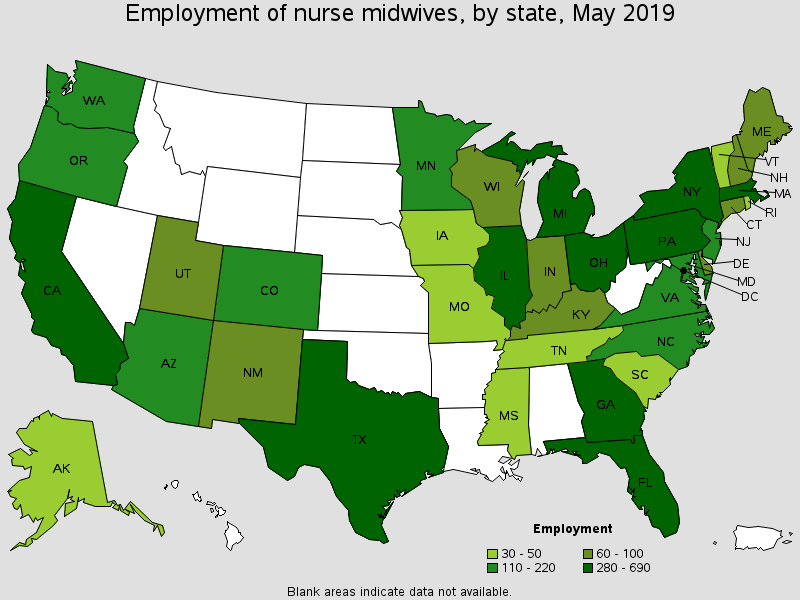
States with the highest employment level in this occupation:
| State | Employment (1) | Employment per thousand jobs | Location quotient (9) | Hourly mean wage | Annual mean wage (2) |
|---|---|---|---|---|---|
| California | 690 | 0.04 | 0.85 | $74.28 | $154,500 |
| Texas | 540 | 0.04 | 0.92 | $44.50 | $92,560 |
| Georgia | 520 | 0.12 | 2.48 | $47.33 | $98,440 |
| New York | 480 | 0.05 | 1.08 | $57.88 | $120,380 |
| Pennsylvania | 400 | 0.07 | 1.42 | $47.44 | $98,680 |
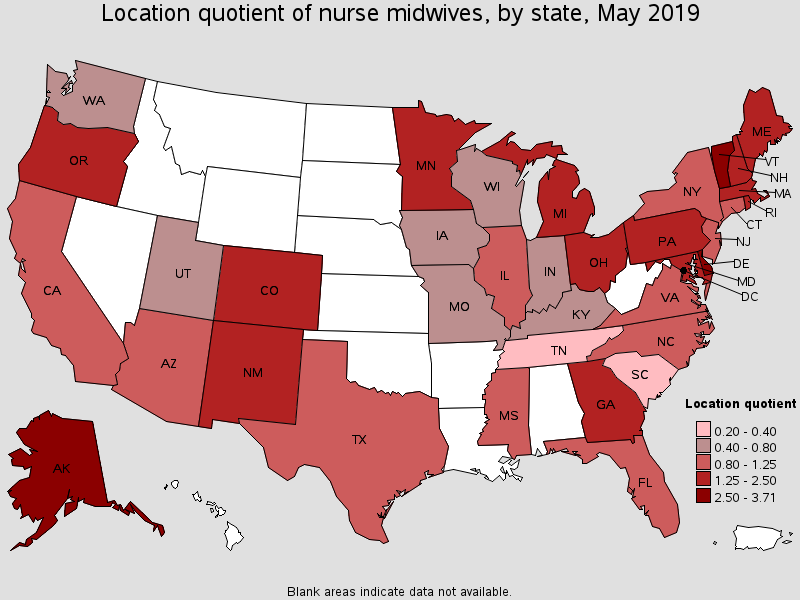
States with the highest concentration of jobs and location quotients in this occupation:
| State | Employment (1) | Employment per thousand jobs | Location quotient (9) | Hourly mean wage | Annual mean wage (2) |
|---|---|---|---|---|---|
| Vermont | 50 | 0.17 | 3.71 | $45.60 | $94,850 |
| Alaska | 50 | 0.17 | 3.53 | $41.31 | $85,920 |
| Delaware | 60 | 0.14 | 2.89 | $45.73 | $95,110 |
| Georgia | 520 | 0.12 | 2.48 | $47.33 | $98,440 |
| New Mexico | 90 | 0.11 | 2.39 | $47.48 | $98,750 |
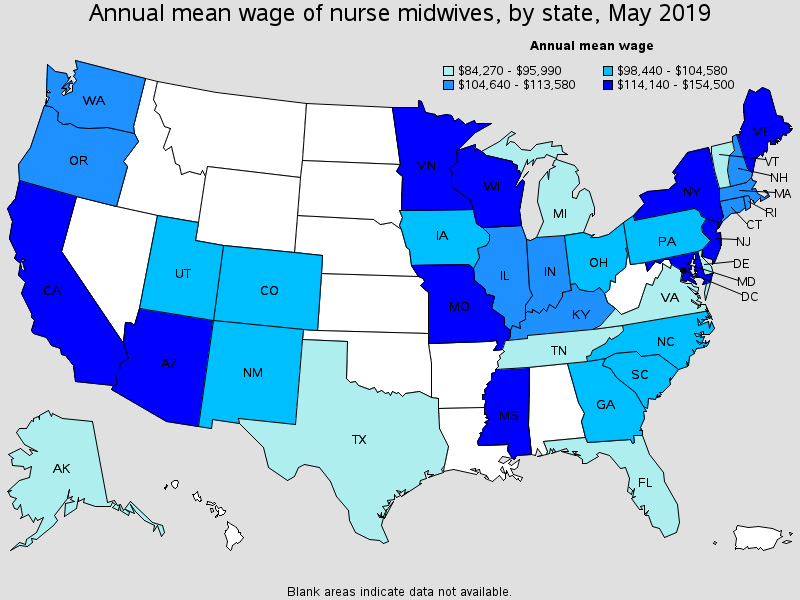
Top paying States for this occupation:
| State | Employment (1) | Employment per thousand jobs | Location quotient (9) | Hourly mean wage | Annual mean wage (2) |
|---|---|---|---|---|---|
| California | 690 | 0.04 | 0.85 | $74.28 | $154,500 |
| Minnesota | 220 | 0.08 | 1.63 | $58.64 | $121,980 |
| New York | 480 | 0.05 | 1.08 | $57.88 | $120,380 |
| Mississippi | 40 | 0.04 | 0.80 | $57.52 | $119,640 |
| Maryland | 170 | 0.06 | 1.29 | $56.85 | $118,240 |
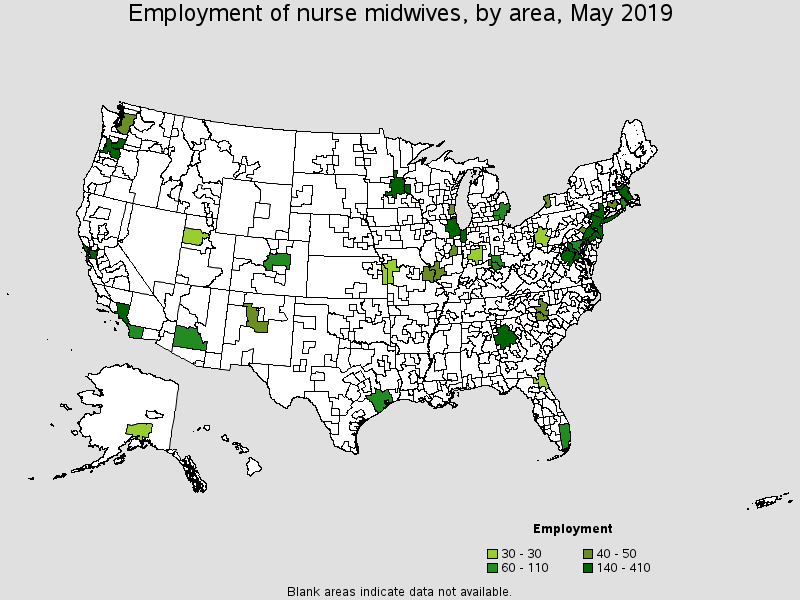
Metropolitan areas with the highest employment level in this occupation:
| Metropolitan area | Employment (1) | Employment per thousand jobs | Location quotient (9) | Hourly mean wage | Annual mean wage (2) |
|---|---|---|---|---|---|
| New York-Newark-Jersey City, NY-NJ-PA | 410 | 0.04 | 0.91 | $56.58 | $117,680 |
| Boston-Cambridge-Nashua, MA-NH | 250 | 0.09 | 1.90 | $49.89 | $103,760 |
| San Francisco-Oakland-Hayward, CA | 230 | 0.09 | 2.00 | $75.22 | $156,450 |
| Atlanta-Sandy Springs-Roswell, GA | 220 | 0.08 | 1.71 | $57.11 | $118,780 |
| Philadelphia-Camden-Wilmington, PA-NJ-DE-MD | 190 | 0.07 | 1.41 | $46.93 | $97,620 |
| Chicago-Naperville-Elgin, IL-IN-WI | 190 | 0.04 | 0.84 | $48.59 | $101,060 |
| Minneapolis-St. Paul-Bloomington, MN-WI | 180 | 0.09 | 1.91 | $58.69 | $122,080 |
| Los Angeles-Long Beach-Anaheim, CA | 160 | 0.03 | 0.55 | $78.37 | $163,020 |
| Portland-Vancouver-Hillsboro, OR-WA | 150 | 0.12 | 2.62 | $54.34 | $113,030 |
| Washington-Arlington-Alexandria, DC-VA-MD-WV | 140 | 0.04 | 0.95 | $49.85 | $103,700 |
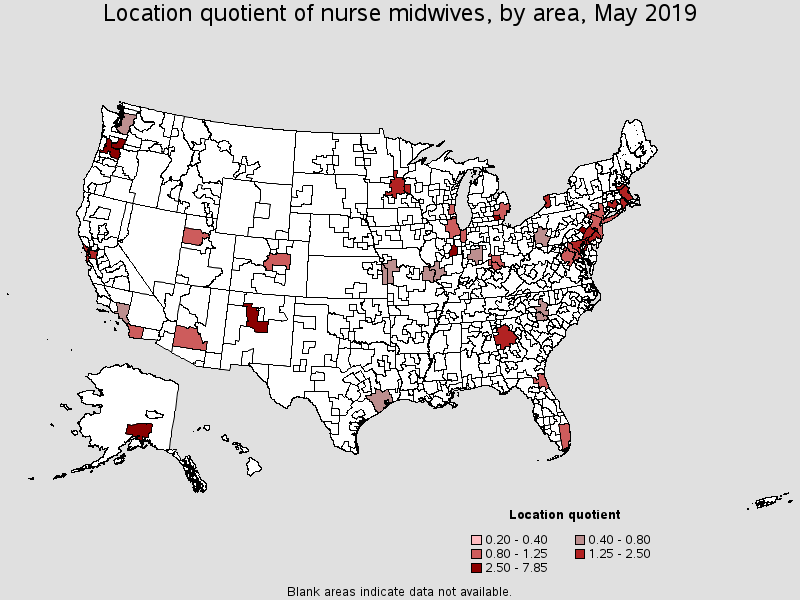
Metropolitan areas with the highest concentration of jobs and location quotients in this occupation:
| Metropolitan area | Employment (1) | Employment per thousand jobs | Location quotient (9) | Hourly mean wage | Annual mean wage (2) |
|---|---|---|---|---|---|
| Champaign-Urbana, IL | 40 | 0.37 | 7.85 | $52.80 | $109,820 |
| Ann Arbor, MI | 60 | 0.26 | 5.55 | $53.73 | $111,750 |
| Reading, PA | 40 | 0.23 | 4.94 | $51.03 | $106,140 |
| Anchorage, AK | 30 | 0.18 | 3.88 | $34.94 | $72,680 |
| Trenton, NJ | 40 | 0.15 | 3.23 | $48.16 | $100,170 |
| Albuquerque, NM | 50 | 0.13 | 2.84 | $46.85 | $97,440 |
| Portland-Vancouver-Hillsboro, OR-WA | 150 | 0.12 | 2.62 | $54.34 | $113,030 |
| Providence-Warwick, RI-MA | 60 | 0.10 | 2.15 | $51.54 | $107,200 |
| Boston-Cambridge-Nashua, MA-NH | 250 | 0.09 | 1.90 | $49.89 | $103,760 |
| San Francisco-Oakland-Hayward, CA | 230 | 0.09 | 2.00 | $75.22 | $156,450 |
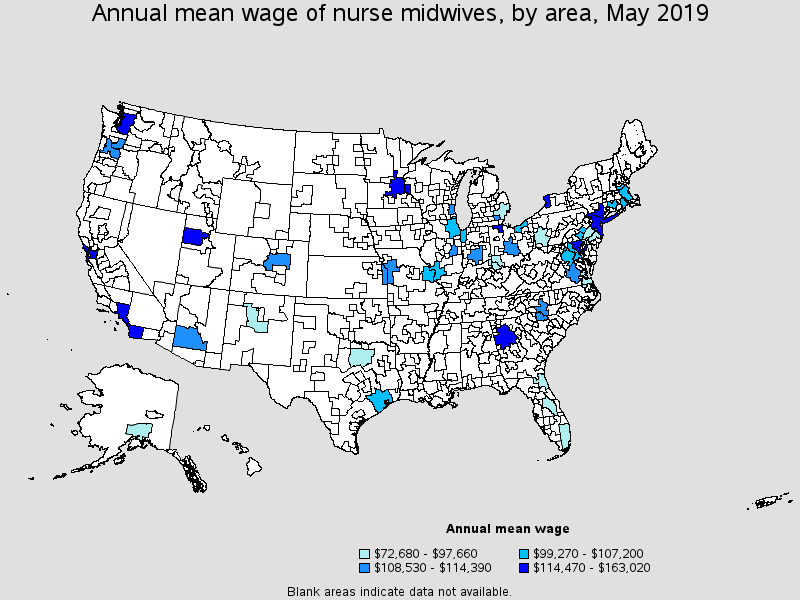
Top paying metropolitan areas for this occupation:
| Metropolitan area | Employment (1) | Employment per thousand jobs | Location quotient (9) | Hourly mean wage | Annual mean wage (2) |
|---|---|---|---|---|---|
| Los Angeles-Long Beach-Anaheim, CA | 160 | 0.03 | 0.55 | $78.37 | $163,020 |
| San Francisco-Oakland-Hayward, CA | 230 | 0.09 | 2.00 | $75.22 | $156,450 |
| San Diego-Carlsbad, CA | 70 | 0.05 | 0.97 | $62.57 | $130,140 |
| Toledo, OH | (8) | (8) | (8) | $62.19 | $129,360 |
| Minneapolis-St. Paul-Bloomington, MN-WI | 180 | 0.09 | 1.91 | $58.69 | $122,080 |
| Atlanta-Sandy Springs-Roswell, GA | 220 | 0.08 | 1.71 | $57.11 | $118,780 |
| Salt Lake City, UT | 30 | 0.05 | 0.96 | $57.08 | $118,720 |
| Baltimore-Columbia-Towson, MD | 100 | 0.07 | 1.54 | $57.00 | $118,570 |
| New York-Newark-Jersey City, NY-NJ-PA | 410 | 0.04 | 0.91 | $56.58 | $117,680 |
| Buffalo-Cheektowaga-Niagara Falls, NY | 40 | 0.06 | 1.38 | $55.27 | $114,950 |
These estimates are calculated with data collected from employers in all industry sectors, all metropolitan and nonmetropolitan areas, and all states and the District of Columbia. The top employment and wage figures are provided above. The complete list is available in the downloadable XLS files.
The percentile wage estimate is the value of a wage below which a certain percent of workers fall. The median wage is the 50th percentile wage estimate--50 percent of workers earn less than the median and 50 percent of workers earn more than the median. More about percentile wages.
(1) Estimates for detailed occupations do not sum to the totals because the totals include occupations not shown separately. Estimates do not include self-employed workers.
(2) Annual wages have been calculated by multiplying the hourly mean wage by a "year-round, full-time" hours figure of 2,080 hours; for those occupations where there is not an hourly wage published, the annual wage has been directly calculated from the reported survey data.
(3) The relative standard error (RSE) is a measure of the reliability of a survey statistic. The smaller the relative standard error, the more precise the estimate.
(7) The value is less than .005 percent of industry employment.
(8) Estimate not released.
(9) The location quotient is the ratio of the area concentration of occupational employment to the national average concentration. A location quotient greater than one indicates the occupation has a higher share of employment than average, and a location quotient less than one indicates the occupation is less prevalent in the area than average.
Other OES estimates and related information:
May 2019 National Occupational Employment and Wage Estimates
May 2019 State Occupational Employment and Wage Estimates
May 2019 Metropolitan and Nonmetropolitan Area Occupational Employment and Wage Estimates
May 2019 National Industry-Specific Occupational Employment and Wage Estimates
Last Modified Date: July 6, 2020